

Helena Uambembe
On the site of the Okavango
07.06. - 27.07.2024
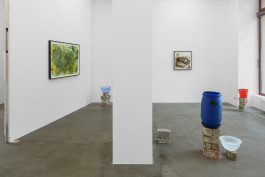
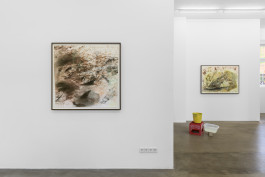
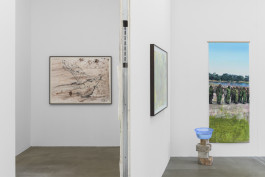
On the site of the Okavango
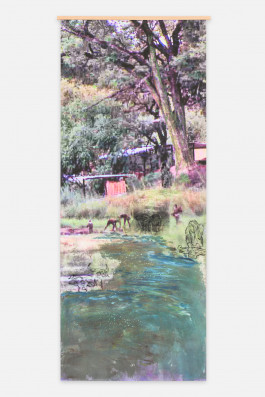
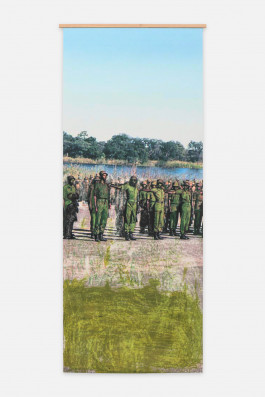
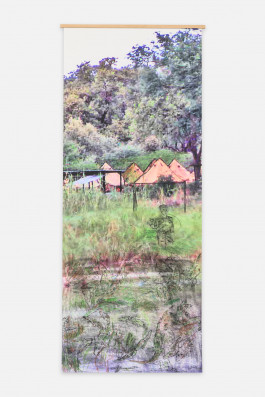
curated by Julian Volz
Der Okavango-Fluss markiert auf einer Strecke von mehr als 400 Kilometern die Grenze zwischen Angola und Namibia. Verteidigt wird der Übergang zwischen den Ländern von Tausenden von Krokodilen, die in dem Fluss leben. Auch der Onkel der angolanisch-südafrikanischen Künstlerin Helena Uambembe bewachte einst diese Grenze. Geflohen aus dem vom Bürgerkrieg gezeichneten Angola, lebten er und der Rest von Uambembes Familie als Teil des 32. Regiments der südafrikanischen Apartheidsarmee zwischen Mitte der 1970er Jahre und dem Ende der 1980er Jahre auf der südlichen Seite des Okavango im damaligen Südwestafrika. Auf seinem Oberarm trug Onkel Titto eine schnell gestochene Tätowierung, die eines der im Fluss lebenden Krokodile darstellte. Das schnell und unauffällig agierende Raubtier diente ihm als Vorbild für sein Handeln als Soldat in einem Stellvertreterkrieg, in den er im Zuge von Angolas Dekolonisierung geraten sollte. In ihrer Ausstellung „On the site of the Okavango“ in der Galerie Anton Janizewski widmet sich die Künstlerin nun dem Wasser des Okavango-Flusses samt den Tieren, die in und an ihm leben, um über die Gewaltgeschichte kolonialer Geografien nachzudenken. Im Okavango verschränkt sich zudem die Geschichte ihrer eigenen Familie mit der des deutschen Kolonialismus, waren es doch das Deutsche Reich und Portugal, die das Gewässer kurz nach der Berliner Afrikakonferenz von 1885 als Grenze zwischen den beiden Kolonialterritorien festlegten.
The Okavango River demarcates the border between Angola and Namibia across a stretch of more than 400 kilometers. This boundary between the two countries is fortified by the thousands of crocodiles that live in the river. The uncle of Angolan-South African artist Helena Uambembe also once guarded this border. After fleeing civil war-torn Angola, he and the rest of Uambembe's family lived on the southern side of the Okavango in what was then South West Africa as part of the 32nd Regiment of the South African Apartheid Army between the mid-1970s and the late 1980s. On his upper arm, Uncle Titto bore a quickly inked tattoo of one of the crocodiles living in the river. The swift and inconspicuous predator served as a model for his work as a soldier in the proxy war in which he became caught up over the course of Angola's decolonization.
In her exhibition "On the site of the Okavango" at Galerie Anton Janizewski, the artist engages with the waters of the Okavango River and its animal inhabitants as a way of reflecting on the violent history of colonial geographies. The Okavango also intertwines the history of her own family with that of German colonialism, as it was the German Empire and Portugal that established the river as the border between the two colonial territories shortly after the 1885 Berlin Africa Conference.
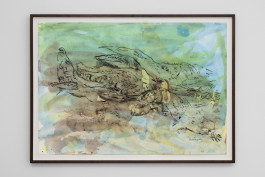
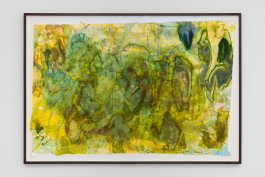
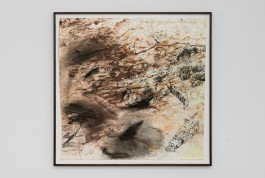
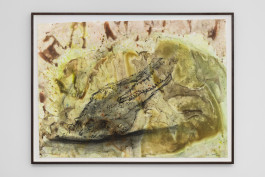
Bio
Helena Uambembe was born in 1994 in Pomfret, South Africa and now lives and works in Berlin, Germany. Her work has been shown in Africa, Switzerland, and Germany, including solo exhibitions at Zollamt of MMK, (Frankfurt, Germany) Jahmek Contemporary Art (Luanda, Angola), The Cultural Institute of Radical Contemporary Arts (CIRCA, Cape Town, South Africa) and FNB Art Joburg (Johannesburg, South Africa). Furthermore, she was part of group exhibitions in Galerie im Körnerpark (Berlin, Germany), INCCA (Johannesburg, South Africa) as well as La Biennale de Lubumbashi VII: Toxicity, Democratic Republic of the Congo and Goethe-Institut South Africa (Johannesburg, South Africa). Helena Uambembe was awarded with the Ars Viva Price (2024), the DAAD Visual Arts Fellowship, Berlin, Germany (2023), the Baloise Art Prize, Basel, Switzerland (2022) and the David Koloane Award, Johannesburg, South Africa (2019).
Helena Uambembe
On the site of the Okavango
07.06. - 27.07.2024

On the site of the Okavango
curated by Julian Volz
Der Okavango-Fluss markiert auf einer Strecke von mehr als 400 Kilometern die Grenze zwischen Angola und Namibia. Verteidigt wird der Übergang zwischen den Ländern von Tausenden von Krokodilen, die in dem Fluss leben. Auch der Onkel der angolanisch-südafrikanischen Künstlerin Helena Uambembe bewachte einst diese Grenze. Geflohen aus dem vom Bürgerkrieg gezeichneten Angola, lebten er und der Rest von Uambembes Familie als Teil des 32. Regiments der südafrikanischen Apartheidsarmee zwischen Mitte der 1970er Jahre und dem Ende der 1980er Jahre auf der südlichen Seite des Okavango im damaligen Südwestafrika. Auf seinem Oberarm trug Onkel Titto eine schnell gestochene Tätowierung, die eines der im Fluss lebenden Krokodile darstellte. Das schnell und unauffällig agierende Raubtier diente ihm als Vorbild für sein Handeln als Soldat in einem Stellvertreterkrieg, in den er im Zuge von Angolas Dekolonisierung geraten sollte. In ihrer Ausstellung „On the site of the Okavango“ in der Galerie Anton Janizewski widmet sich die Künstlerin nun dem Wasser des Okavango-Flusses samt den Tieren, die in und an ihm leben, um über die Gewaltgeschichte kolonialer Geografien nachzudenken. Im Okavango verschränkt sich zudem die Geschichte ihrer eigenen Familie mit der des deutschen Kolonialismus, waren es doch das Deutsche Reich und Portugal, die das Gewässer kurz nach der Berliner Afrikakonferenz von 1885 als Grenze zwischen den beiden Kolonialterritorien festlegten.
The Okavango River demarcates the border between Angola and Namibia across a stretch of more than 400 kilometers. This boundary between the two countries is fortified by the thousands of crocodiles that live in the river. The uncle of Angolan-South African artist Helena Uambembe also once guarded this border. After fleeing civil war-torn Angola, he and the rest of Uambembe's family lived on the southern side of the Okavango in what was then South West Africa as part of the 32nd Regiment of the South African Apartheid Army between the mid-1970s and the late 1980s. On his upper arm, Uncle Titto bore a quickly inked tattoo of one of the crocodiles living in the river. The swift and inconspicuous predator served as a model for his work as a soldier in the proxy war in which he became caught up over the course of Angola's decolonization.
In her exhibition "On the site of the Okavango" at Galerie Anton Janizewski, the artist engages with the waters of the Okavango River and its animal inhabitants as a way of reflecting on the violent history of colonial geographies. The Okavango also intertwines the history of her own family with that of German colonialism, as it was the German Empire and Portugal that established the river as the border between the two colonial territories shortly after the 1885 Berlin Africa Conference.


Helena Uambembe was born in 1994 in Pomfret, South Africa and now lives and works in Berlin, Germany. Her work has been shown in Africa, Switzerland, and Germany, including solo exhibitions at Zollamt of MMK, (Frankfurt, Germany) Jahmek Contemporary Art (Luanda, Angola), The Cultural Institute of Radical Contemporary Arts (CIRCA, Cape Town, South Africa) and FNB Art Joburg (Johannesburg, South Africa). Furthermore, she was part of group exhibitions in Galerie im Körnerpark (Berlin, Germany), INCCA (Johannesburg, South Africa) as well as La Biennale de Lubumbashi VII: Toxicity, Democratic Republic of the Congo and Goethe-Institut South Africa (Johannesburg, South Africa). Helena Uambembe was awarded with the Ars Viva Price (2024), the DAAD Visual Arts Fellowship, Berlin, Germany (2023), the Baloise Art Prize, Basel, Switzerland (2022) and the David Koloane Award, Johannesburg, South Africa (2019).